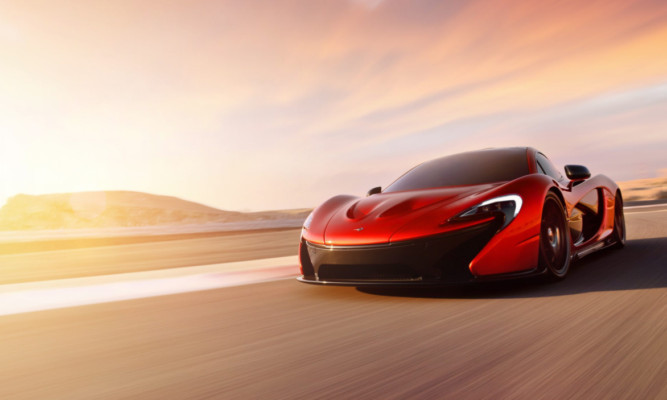You might not get much change from £900,000, but driving a new McLaren P1 hybrid off the forecourt will give you an eye-watering 903 brake horsepower supported by one of the most sophisticated batteries ever produced.
The P1 regarded as successor to the famous McLaren F1 is being taken on a global tour in an attempt to entice mega-rich buyers from the Middle East and North America.
But the oil barons and film stars will probably have no idea that an integral part of the machine was painstakingly designed and built, piece-by-piece, on an industrial estate on the northern fringes of Dundee.
Technology created by Axeon is at the heart of the hypercar, with the firm in the midst of creating 375 of the supremely energy-dense power packs used to help drive the millionaire’s plaything.
The contract is just the latest exciting project being delivered by the Wester Gourdie-based company, which was snapped up by international chemicals and precious metals giant Johnson Matthey for more than £40 million late last year.
https://youtube.com/watch?v=CTjbgKWcP4Y%3Frel%3D0
The group, which employs 70 people at its city research and development base, said it had been working with McLaren on the development of the battery pack for years. It includes cooling technology involving materials originally spun out from NASA, as well as precision connector technology and complex thermal and battery management systems to ensure best performance.
Fractions of millimetres have been shaved off hardware wherever possible to help keep the overall weight of the car down, and control software is fine-tuned.
“There are huge amounts of power coming out of that battery, meaning we need really advanced thermal management,” said the firm’s European operations manager Stuart Paterson. He said heat-conductive glue and laser welding are used to create the most powerful battery pack possible, all with weight and efficiency in mind.
The resulting unit creates 140 bhp on its own, adding even more clout when teamed with the P1’s 3.8-litre twin-turbo V8.
Axeon has a long history of developing automotive batteries, having created units for use on prototype and research editions of the Rolls-Royce Phantom, Land Rover Defender and Jaguar XJ, converted delivery vehicles, and even supplied battery power packs for use in US garbage trucks.
As well as close relationships with its clients, Axeon also enjoys strong links with the suppliers of the cells it uses to build its battery packs.
These cells which range from blue units the size of those in remote controls to foil-covered packs the size of cereal boxes are carefully linked together to create Axeon’s precision products.
https://youtube.com/watch?v=Hb_6pNFqqNA%3Frel%3D0
First, though, the company must understand their individual properties, so it conducts a comprehensive testing regime of all the cells it uses.
It seeks to test each to its individual limits in all kinds of temperature and atmospheric conditions, assessing its charge life and recharge time under lab conditions. As a result, the firm has one of the most detailed cell performance databases in the world.
Axeon also works alongside the academics and innovators creating the next generation of lithium battery cells, like St Andrews University’s Professor Peter Bruce.
Altering the chemical compounds used within batteries can increase their energy density, and therefore the range they could achieve as power sources for vehicles.
The lithium air cell, currently under development, has the potential to multiply energy density by several times but is not expected to be commercially viable for automotive applications until the mid-2020s.
Axeon also produces battery packs for electric bikes and power tools, and is increasingly exploring opportunities in renewable energy.
“In Dundee, we’re all about R&D, small-scale manufacture and cutting-edge technology, but in Poland it is about volume,” Mr Paterson said.
“In Gliwice, we have 450 people doing a range of batteries for different applications, but the core business is batteries for power tools.
“About 18 months ago, we started producing batteries for electric bike systems. The market has seen huge growth over the last few years and is forecast to grow much, much more.”
Around 32,000 bicycle battery kits are manufactured each month for burgeoning markets in Continental Europe.
Having recognised the intermittency of renewable power generation, the company is examining opportunities for energy storage in that field, too.
“We’re looking at whether batteries can help to balance that oversupply,” said the firm’s marketing and corporate affairs manager Rebecca Trengove.
“We’ve got power being generated by windfarms which it is possible could be stored, even if for short periods.
“It’s established that there could be a part for batteries to play in that, but we’re just scratching the surface of the opportunities,” she said.
Mr Paterson said Axeon, which has an annual turnover of about £47m, would gain from being under Johnson Matthey’s worldwide umbrella.
“Where it is benefiting us is in the skills they have in manufacturing, and particularly with chemicals, and in the quality systems we need to be adopting,” he said.
The company is growing its head count under the new ownership and as it finds increasing market opportunities.
“This is quite a dynamic environment,” Mr Paterson said. “But we know from experience that the skillset and calibre of engineers that we seek to attract does exist in the city.”
